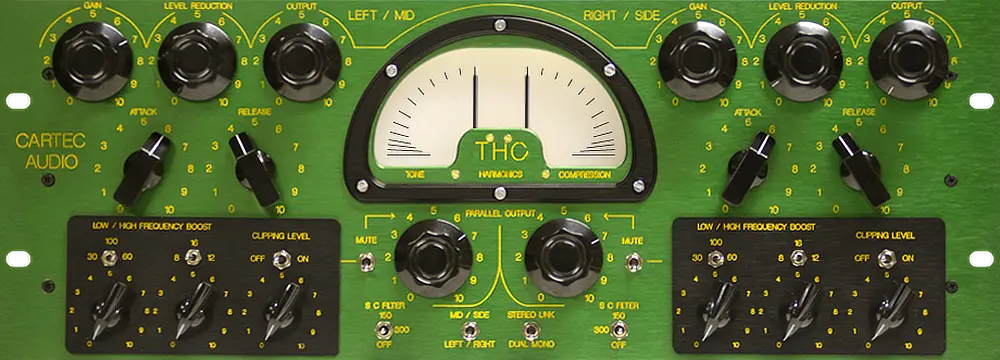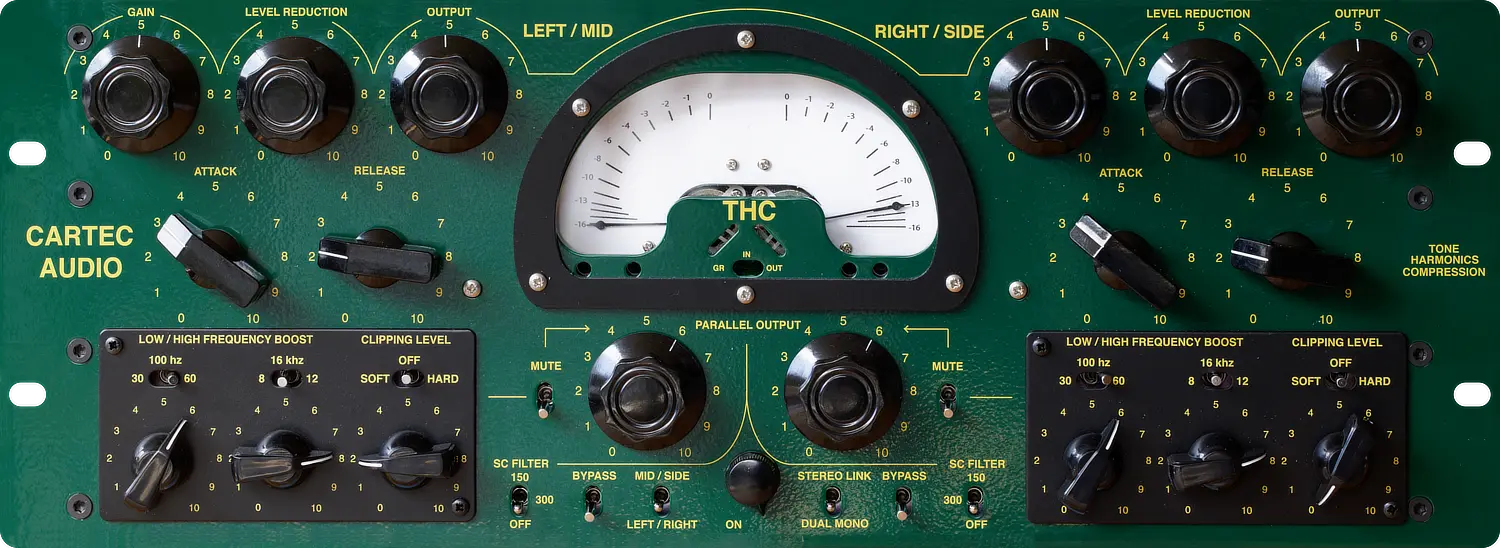The Cartec Audio THC is a two-channel hybrid compressor that employs eight valves and four discrete amplifiers to achieve a unique level of control over dynamic range, harmonic distortion content, and tonal balance.
After the transformer coupled input, audio is split into two separate parallel processing paths. The first stage is a pair of variable transconductance EF183 valves operating in a push-pull configuration and feeding an ECC82 with an interstage transformer. By varying the input and output level in different proportions, this stage can change from fast, transparent compression, to a more aggressive crushing character with added distortion.
The second stage of the Cartec Audio THC which splits from a separate winding of the input transformer, is intended to be blended together with the compressed output to either restore some natural dynamics or add extra character. This uncompressed or ‘Dry’ signal is passed through a set of passive filters which allow three different bass and three different treble shelving frequencies to be boosted, should you want to blend a higher amount of a particular uncompressed frequency range.
In combination with this is a variable asymmetrical clipping threshold, which can greatly increase the second harmonic content for anything from subtle warming to heavy distortion and added to taste or even used as an effect on its own.
Both signal paths each have a separate output fader before the discrete mix bus and transformer coupled output amplifier. The Cartec Audio THC can also form a passive Mid/Side encoding and decoding matrix with its input and output transformers and features a switchable sidechain high pass filter at two frequencies.

GAIN – The GAIN control of the Cartec Audio THC is the first stage and determines the signal level to feed the balanced pair of input valves. This control comes after the input transformer and has the most dramatic effect on the coloration of the compressor as the gain reduction valves are ultimately driven into saturation.
LEVEL REDUCTION – The LEVEL REDUCTION control acts as a threshold and determines the control voltage that is generated from the output. The control voltage is a negative DC signal that is fed back to the input of the first valve stage, to reduce its gain, or more correctly its ‘Mutual Transconductance’. This is how the compression effect is achieved. Firstly, the control voltage is sent through the ‘Attack’ and ‘Release’ controls.
OUPUT – This OUTPUT control of the Cartec Audio THC is a fader that sets the amount of the valve compressor channel (as opposed to the solid-state parallel channel), that is sent to the rear XLR output connector. A large amount of signal is typically available before this control, and it is quite normal to spend most of the time between 1 to 5 range, depending of course on the input signal level and compression amount.
ATTACK – The ATTACK control determines how quickly the compressor reacts to the transients of the audio. For the fastest attack time, set the control to 0, and for the slowest to 10. Faster attack times around the 1 to 4 range may be more useful for general level control. Times above the 5 setting can be interesting for retaining punch in percussion and other effects.
RELEASE – The RELEASE control determines how long the compressor takes to recover after entering gain reduction. For the fastest release time, set the control to 0, for the slowest to 10. Faster release times around the 2 to 4 range may be most useful for general level control. Times above the 5 setting can be particularly long, but 0 to 1 can create good effects with percussion, especially in combination with a slow attack time.
LOW – This is the shelving Low Frequency boost control. The circuit is similar to the EQP-1A and is completely passive, with three frequencies of 30, 60 and 100Hz selectable. This control is in the Parallel Output signal path and is intended to be used for adding in extra uncompressed low frequency content to the main outputs.
HIGH – This is the shelving High Frequency boost control. The circuit is similar to the EQP-1A and is completely passive, with three frequencies of 8, 12 and 16kHz selectable. This control is in the Parallel Output signal path and is intended to be used for adding in extra uncompressed high frequency content to the main outputs.
CLIPPING LEVEL – The CLIPPING LEVEL is a unique feature, using a hybrid circuit of discrete opamps, and a valve. This control adds gain to the signal, which then feeds this stage that has a set ‘headroom’ level. Once the signal reaches this level, depending on the mode, extra harmonics are generated as the waveform is clipped. ‘Soft’ is predominantly lower order second harmonic, and ‘Hard’ produces more higher order 2nd and 3rd harmonics.
SC FILTER – The side chain filter switch acts only upon the audio signal that determines the compression amount. If this is set to 150 for instance, then the compressor will be less sensitive to frequencies below this. There are two options of 150Hz and 300Hz.
BYPASS – The BYPASS switch activates two relays that completely hard bypass the unit by disconnecting the input and output transformers and connecting the input and output XLR connectors together.
MID/SIDE – The MID/SIDE switch activates a group of relays that switch the arrangement of both input and output transformers to create a passive Sum/Difference encoder and decoder. In this mode, the left-hand channel of the unit will now control all of the mono information that is present in both left and right, and the right-hand channel will control all of the stereo information, i.e. anything that is not equally present in booth left and right signals. This can be an extremely useful tool over the mix bus.
PARALLEL OUTPUT – This PARALLEL OUTPUT control is a fader that sets the amount of the solid state ‘dry’ channel that is sent to the rear XLR output connectors. The great versatility of the Cartec Audio THC lies in how this channel is used. Either it could be blended in with the Compressor output for parallel compression effects, to restore some of the natural dynamics, or it could have the compressed level brought up under it, to increase the loudness. Any combination of EQ and clipping can be used to find a balance between all the desired elements of tonal balance and harmonic content.



